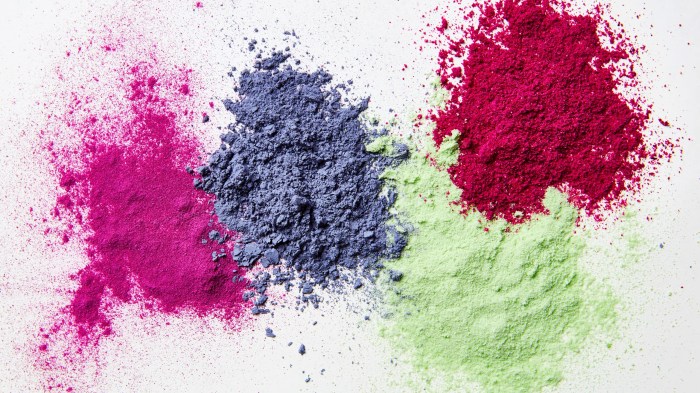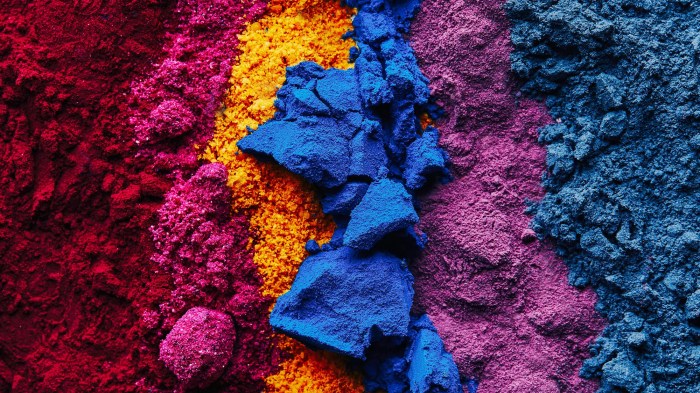Market Overview of Natural Food Coloring Powders

Yo! So, natural food coloring powders, huh? Turns out, it’s not just about making your cupcakes look like a rainbow exploded. This market is booming, man. We’re talking a serious shift from artificial colors to something people perceive as healthier and more “natural.” Think of it as the avocado toast of the food coloring world – everyone’s jumping on the bandwagon.
The market’s pretty big, and getting bigger. While precise numbers fluctuate depending on the research firm and year, we’re talking hundreds of millions of dollars globally, with a projected annual growth rate that’s pretty impressive. This growth is driven by increasing consumer awareness of the potential health risks associated with artificial food coloring, coupled with the rising demand for clean-label products.
Basically, people are reading labels more carefully, and they’re ditching anything that looks suspiciously chemical.
Key Players and Market Share, Natural food coloring powders
Okay, so who’s winning this coloring contest? There are several big players, but the market isn’t dominated by a single giant. You’ve got companies specializing in specific pigments, like turmeric for yellow or beetroot for red, and then there are larger players offering a wider range of colors. Some of these are established food ingredient suppliers branching into the natural color segment, while others are startups focused solely on natural colors.
While natural food coloring powders offer vibrant hues from plant-based sources, some bakers prefer the intense concentration of gel food colorings. For those seeking that vibrant intensity, finding a reliable source is key; you can check out options on where to buy gel food coloring here to compare prices and brands. Ultimately, the choice between powders and gels depends on the desired outcome and intensity of color in your final product.
Pinpointing exact market shares is tricky because companies don’t always publicly release that kind of info, but think of it like this: it’s a pretty competitive landscape, with smaller, specialized brands often carving out niches.
Distribution Channels
Where can you get your hands on this stuff? Everywhere, basically. Online retailers like Amazon are a huge channel, offering convenience and a wide selection. Then you’ve got your regular grocery stores, with natural food sections increasingly stocking these powders. Specialty stores catering to bakers and food artisans are another important outlet.
Even some larger food service distributors are getting in on the action, supplying restaurants and cafes looking for natural alternatives.
Price Comparison of Natural Food Coloring Powders
Let’s talk price. Prices vary wildly depending on the color, the brand, and the quality (organic, non-GMO, etc.). This table gives you a rough idea – prices are approximate and can change. Always check the current price on the retailer’s website.
| Brand | Color | Size (oz) | Approximate Price (USD) |
|---|---|---|---|
| Brand A | Red (beetroot) | 2 | $10 |
| Brand B | Yellow (turmeric) | 1 | $6 |
| Brand C | Green (spirulina) | 4 | $20 |
| Brand D | Blue (butterfly pea flower) | 2 | $12 |
Future Trends and Innovations

Yo! So, the natural food coloring powder game is blowing up, right? It’s not just about avoiding artificial stuff anymore; it’s about cleaner labels, healthier choices, and frankly, some seriously vibrant food. We’re talking a whole new level of foodie obsession here, and the future is looking…well, pretty colorful.The demand for organic and non-GMO options is exploding faster than a TikTok trend.
People are reading labels like detectives, sniffing out anything remotely suspicious. This means companies need to get serious about sourcing and transparency. We’re talking traceable ingredients, sustainable farming practices, and certifications that actually mean something. No more shady business, guys.
Growing Demand for Organic and Non-GMO Options
This isn’t just a fad, peeps. The market for organic and non-GMO products is consistently expanding. Think about it: more and more people are prioritizing health and ethical consumption. This translates directly into a higher demand for natural food colorings that meet these stringent standards. Companies that can’t keep up will be left in the dust.
We’re seeing a clear shift in consumer preference, with brands like Annie’s Homegrown and Imagine Foods leading the charge. Their success is a testament to the growing market power of conscious consumers.
Innovations in Production and Application
Forget those old, clunky methods. We’re talking about advanced extraction techniques, precise color standardization, and sustainable processing. Imagine: super-efficient methods that minimize waste and maximize color yield. This is where the real innovation is happening. Think about the development of more stable and versatile powders, which can withstand various processing conditions without losing their vibrancy.
That’s the kind of game-changer we’re looking at. One example is the use of supercritical CO2 extraction, which offers a greener and more efficient way to extract color from natural sources.
Technology’s Role in Quality and Consistency
Technology is no longer just a fancy word; it’s the backbone of this whole operation. Sophisticated spectrophotometers ensure color consistency across batches. Advanced imaging techniques help optimize extraction processes. And data analytics? Forget about guesswork; we’re talking precise predictions of color stability and shelf life.
This allows for better quality control and reduces waste, leading to a more sustainable and cost-effective production process. Companies are investing heavily in these technologies to guarantee product quality and meet the growing demands of the market.
Future Applications of Natural Food Coloring Powders
The possibilities are endless, dude. Think beyond just cakes and cookies. We’re talking vibrant plant-based meats that actuallylook* like meat, naturally colored dairy alternatives that don’t look like they came from a science experiment, and even cosmetics with those naturally derived pigments. Imagine a bright pink vegan burger, its color coming from beet powder, looking so juicy and delicious it makes your mouth water.
Or a vibrant orange carrot cake, its hue derived from turmeric, with a texture so moist and fluffy you’ll swear it’s the best you’ve ever tasted. These aren’t just dreams; these are possibilities being explored and implemented by innovative food companies.
FAQ Explained
Are natural food coloring powders safe for consumption?
Generally, yes! However, always check the specific ingredients and any potential allergies. Source from reputable brands.
How long do natural food coloring powders last?
Store them in airtight containers in a cool, dark place. Their shelf life varies depending on the type of powder, but generally, you can expect several months.
Can I use natural food coloring powders in everything?
Most foods work great, but some might react differently. Test a small amount first, especially with delicate recipes.
Where can I buy natural food coloring powders?
Online retailers, health food stores, and some larger supermarkets often carry them.
